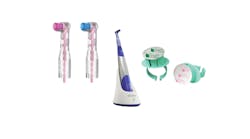Providing positive experiences for the children in our hygiene chair allows appointments to flow smoothly and helps foster a lifelong healthy patient-provider relationship. Caring for our smallest patients is a privilege, but one that can also be challenging and difficult when things don’t go as planned.
It’s easy (and human) to immediately respond to a pediatric patient’s squirming and extreme displays of emotion with frustration and irritation, but we need to take the time to understand the reasons for such behavior as well as applicable ways to modify it. Learnings from child psychology for the better part of the last century indicate that fear, anxiety, and pain are often triggers for complications in the dental setting.1 Using intuition or “gut feeling”—acknowledging and embracing the “humanness” of the patient we are caring for—can quickly deescalate tense situations and prevent future issues from arising.
Here are some considerations for applying intuitive patient care with pediatric hygiene patients.
Body language and verbal cues
While crying and emotional outbursts are obvious signs of a child’s fear about their hygiene visit, taking notice of smaller, less conspicuous signs can allow the clinician to take a more preventive approach to avoid catastrophe. Research has shown that children who are feeling anxious or fearful in their environment will often be hypervigilant of their surroundings, scanning the room for signs of danger. This is often accompanied by a tense posture, lack of eye contact, resistance to adhere to instructions, heightened sensitivity to stimuli, lack of verbal communication, or an unwillingness to leave their parent’s or guardian’s side.2 Asking multiple questions or expressing worry about the visit are also considered signs of fear.
You might also be interested in: The golden years: Considerations for our geriatric patients
Respond appropriately
It’s not enough simply to notice signs of unease with pediatric patients. These observations warrant a response from the clinician to accommodate a child’s needs. Some basic recommendations for acting on clinical intuition include:
- Lowering yourself to the child’s eye level
- Maintaining gentle eye contact
- Speaking in a calm voice
- Asking the child open-ended questions with the intent to understand their feelings
- Explaining and demonstrating the steps of the appointment in simple, fun terms that are age appropriate
Based on how the child responds, you can place emphasis on specific techniques that yield success. Remember that every child is different—this is where intuition can guide you as you navigate each pediatric visit.
Human-to-human care is best
Regardless of the stress we may be experiencing during a tense pediatric visit, we need to remember that children are people who deserve the same respect, compassion, and consideration as adolescent and adult patients. When approaching clinical care with a child, empathy is the key that will ultimately result in a relationship founded on trust and understanding. Providing a child with a safe space to communicate their concerns is a basic human right, and learning to discern behavioral patterns, following instinctual cues, and taking preemptive action to avoid traumatic experiences at the dental office is what separates an extraordinary clinician from the average. Becoming a student of our intuition requires intention and effort, but patients—especially our youngest ones—will recognize the difference.
References
1. Sheshukova OV, Polishchuk TV, Kostenko VG, Trufanova VP, Bauman SS, Davydenko VY. Consideration of childhood psychological factors at dental appointment. Wiad Lek. 2018;71(7):1305-1309.
2. Chiu A, Falk A, Walkup JT. Anxiety disorders among children and adolescents. Focus (Am Psychiatr Publ). 2016;14(1):26-33. doi:10.1176/appi.focus.20150029






